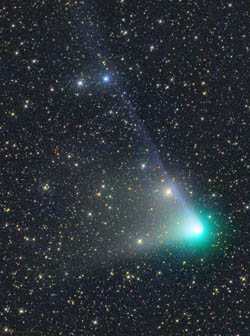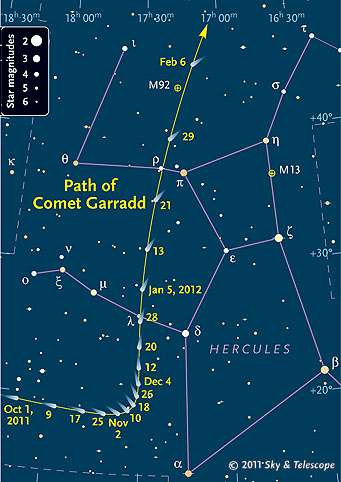Last night was a special one here in Boston: crystalline skies, decent seeing, comfortably cool weather, and no wind. Taking advantage of all this, I homed in on Comet Garradd (C/2009 P1) with the exquisite 25-inch telescope at the Clay Center Observatory.

Austrian observer Michael Jäger recorded Comet Garradd (C/2009 P1) on the evening November 25th with a 10-inch telescope nd a CCD camera. Note the thin, bluish gas tail extending upward from the coma. Click on the image for a larger view.
Michael Jäger
Despite interference from modest suburban light pollution and a first-quarter Moon, I had high expectations as I climbed to the eyepiece. Observers have been reporting that Comet Garradd is roughly 6½ magnitude, suggesting easy viewing even in binoculars or a small telescope. A recent image taken by Austrian astrophotographer Michael Jäger (shown here) shows that the comet now sports a strongly condensed coma, broad dust tail, and pencil-thin gas tail.
But the comet was not the boffo performer I’d hoped to see. It was certainly obvious through the 25-inch. I could see the dust tail’s extension away from its well-condensed nucleus. But the gas tail was a no-show, and I only barely glimpsed the comet at all in a piggybacked 7-inch f/9 refractor. Sadly, the light pollution and moonlight had taken a toll.
When observers report that a comet (or a nebula or a galaxy) is, say, 7th magnitude, they typically mean that the light from the entire object, if concentrated in a single point, would be as bright as a 7th-magnitude star. The more diffuse, or spread out, the light is, the more difficult the object will be to see — especially in a less-than-pitch-black sky.
So for those of you wishing to view Comet Garradd, try to do it when the Moon isn’t in the way. Fortunately, the comet has started moving northward through Hercules (where it’s resided since mid-September), and will soon be just as easy to see in the morning sky before dawn. As my S&T colleagues Alan MacRobert and Tony Flanders mentioned a few months ago, the best observing opportunities will tip in favor of predawn viewing in mid-December. But that’s also when the nearly full Moon shows up. So pick your times carefully.

Comet Garradd crosses Vulpecula and Sagitta in early September, then remains in Hercules for the next six months. Click on the map for a full-page, printable finder chart.
S&T Diagram
The good news is that Comet Garradd will be around for several more months, and you can click here for a full-page, downloadable finder chart. The comet reaches perihelion on December 23rd, at a point 1.55 astronomical units (145 million miles) from the Sun — but this icy visitor won’t likely be at its best until February, when its estimated total magnitude should be at or slightly better than 6.0. In late January, Comet Garradd cruises along the east side of the Keystone in Hercules, and on the morning of February 3rd it’s just ½° from the globular cluster M92.
By the way, our online gallery contains lots of nice images taken by many talented amateurs. And Gary Kronk’s “Cometography” website has a great summary about the comet’s discovery (by Gordon Garradd more than two years ago) and its development since then.
 2
2









Comments
Will
December 2, 2011 at 3:00 pm
I observed the comet, (when it was high up), many times in September, and I could actually detect the beginning of a tail, although not the entire thing, in my 4.5 inch newtonian. I haven't seen it since September 30th, and I tried once in November, but it was too low on the horizon to see. So I look forward to seeing it in the morning sky this month, and seeing it reach it's peak in February, and especially getting a good glimpse of it near M92, which shows very nicely in my scope, and actually appears brighter than M13 nearby, will definitely have to sketch that.
Honestly, I would have been tempted to aim that 25 inch scope at the Moon!
You must be logged in to post a comment.
Randall
December 3, 2011 at 10:08 am
Why is it green? Is that real or just image manipulation?
You must be logged in to post a comment.
You must be logged in to post a comment.